A Few Facts
First a few facts; solar radiation incident on earth’s surface is weak. As such solar photovoltaic cells can at best convert anywhere between 16% to 20% of this incident energy or sunlight into electricity only. This low efficiency coupled with multiple issues like cable loss, temperature variation, dust and DC/AC conversion issues means a solar panel can’t produce much electricity. It is because of this reason a large tract of land is needed to setup optimum power generation capability.
Since only plain barren wasteland can be used, which is not readily available; it’s better to use floating solar farms to generate power. It’s also a fact that island nations such as Philippines, Korea, Singapore, and Japan where land in itself is scarce, floating solar power plant on water bodies like sea, ocean, lakes, ponds, reservoirs, dams, water tanks is the best option to produce clean, green energy. An attractive alternative to the land based solar power generation; it involves no cost as compared to incurred for land acquisition for land based solar farm.
Another fact is owing to exposure to sunlight water evaporation can result in scarcity of clean potable water; and during summer when temperatures are high the evaporation happens even faster. According to reports released in March 2017, water loss due to evaporation in Jayakwadi dam of Maharashtra during monsoon season was anywhere between 0.4-0.5 mcum/day (million cubic meters per day), and during summer season it went up to 1.3 mcum/day. In March 2017 alone, the reservoir reportedly lost 36.01 mcum/day which is equal to around one month’s drinking water supply for city of Pune, Maharashtra. Many attempts to stop this rapid evaporation have failed. A floating PV solar panel farm setup on the dam can save a lot of water from being evaporated. As is known a floating solar plant creates a shade over water, thereby substantially cutting down exposure of water to sunrays.
Floating Solar Power Plant- An Overview
India is the world’s third largest emitter of greenhouse gases; and relies heavily on coal fired power plants, a non-renewable polluting source to meet more than 50% of its total power generation requirement. Also, nearly 40% of Indian households still have no access to electricity. It is because of this reason the government has planned to generate up to 100 GW of power using solar panels by the year 2022. However, setting up a solar power is not easy. The land on which the photovoltaic solar array farm is to be erected needs to be barren waste land, as per government rules. Getting hold of such plot is not easy, due to many factors; it is here that floating solar plant comes in the picture.
A floating solar power plant is set up on a water body whether it is a lake, river, reservoir or sea and even abandoned water filled open cast mining sites. The solar power plant setup on water not only conserves land and also increases efficiency of the photovoltaic module. Not just that, setting up solar plant over water body does away the need to source ground water for cleaning of the solar panels. It also helps to reduce evaporation of water. The solar power plant can be installed on a pond, lake, reservoir, or on any other water body.
Since the main savings of setting up floating solar farm are in terms of land prices and yield cost; viability of floating PV plants in India is huge. Demand for clean and renewable energy continues to grow with consistent threat of pollution from non-renewable energy resources like nuclear power, coal and oil; not to mention their dwindling supply. Another factor that works in favour of floating solar plants is the scarcity of waste land and even if available the problem of accessibility persists.
As is known the floating solar plant is an array or farm of photovoltaic panels that has been built on a structure that floats on body of water. Some of the major floating PV plants installed in India include the 1 MW floating PV plant in Kota barrage and Kishore Sagar lake in Kota, Rajasthan; 500 KWp (kilowatt peak) solar plant in the Banasura Sagar reservoir in Wayanad, Kerala, spread over 1.25 acres of water surface, currently making it the largest project in India.
A few more projects are in the offing by National Hydro Power Corporation (NHPC). Not just that a floating solar plant is also environment friendly option as it helps to save water but also cut down on CO2 emissions. For example, the 1 MW floating solar plant at Kota barrage can save up to 37 million litres of water by stopping evaporation and reduce CO2 emissions by 1,714 tonnes per annum. A floating solar plant not only saves on cost of acquiring land but also brings down power generation expenses. Mr. Gon Chaudhuri of NB Institute of Rural Technology says that India could generate around 300 GW of solar power just by tapping into 10-15% of available water bodies across India, especially in the states of West Bengal, Bihar, Kerala, Odisha and Assam.
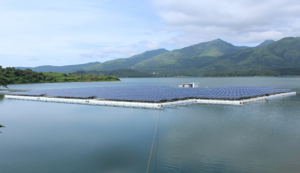
India’s Largest Floating Solar Power Plants in Kerala
The largest floating solar power plant or solar farm and the first of its kind in India is in Kerala. It has been commissioned and grid connected as recently as December 2017. The floating solar power plant setup on the Banasura Sagar reservoir in Wayanad, Kerala has a power generation capacity of 500 kWp (kilowatt peak). The plant managed by Kerala State Electricity Board (KSEB) is built at a cost of INR 9.25 crore floats on 1.25 acres of water and has 1938 high-efficiency solar panels installed on 18 ferro cement floaters supported by a floating substation and other electrical products like transformers, inverters, control and data acquisition system to monitor power generation beside an anchoring system to hold the floating solar project together.
According to reports, the floating solar power plant on Banasura Sagar reservoir is expected to generate 7.5 lakh units of power per annum; and the power generated will be fed in to the KSEB grid by underwater cables. It is in fact a scaled up version of already commissioned pilot project of 10 kW floating solar project that was inaugurated at the same site in Banasura Sagar reservoir in October 2017. This floating solar plant will function alongside a 400-kW solar power project installed on top of dam walkway. Ad Tech Systems Ltd, a Trivandrum, Kerala based firm was instrumental in setting up the plant. The solar plant is expected to help Kerala go a long way to scale up its power generation capacity; as current resources meet only 30% of requirement and the state is forced to source the remaining 70% from other states.
The 1938 solar panels in the plant have a power generation capacity of 260 watts each. The plant also has a 500 KVA transformer and a total of 17 inverters. Kolkata based Renewable Energy College (REC), India’s first ever renewable energy college was instrumental in providing the technical knowhow for setting up the floating solar power plant. REC developed a system that reportedly generates more power from floating solar power than the similar ones erected on land. In the technology devised by REC, solar panels are installed on floating platforms are anchored to keep them in one place. The only issue now remaining is to figure out how to ensure the solar panels withstand strong winds.
The main challenge for setting up the project was adjusting to the variation in water level that varies up to 21 meters between summer and monsoon seasons; due to heavy inflows. As such it was important to design a specialized anchoring system that could withstand not just the variation in water level but also high winds. The solar modules were sourced from Radiant Solar, a Hyderabad, Telangana-based solar module manufacturer with inverters from ABB. The floats designed with ferrocement, as it makes the structure more stable. Like other floating solar power systems this project is also designed to save water from evaporation, ensure solar panels are quickly cooled leading to more efficiency in power generation.
Up until the Wayanad project; the largest floating solar photovoltaic (PV) plant in India was at Rajiv Gandhi Combined Cycle Power Plant (RGCCPP) at Kayamkulam in Kerala. The 100 kWp (kilowatt peak) floating solar plant setup by NTPC (National Thermal Power Corporation Limited) in March 2017 as part of Government’s ‘Make In India’ initiative used a technology or system that was indigenously developed by NETRA (NTPC Energy Technology Research Alliance), the Research and Development arm of NTPC, in collaboration with Chennai based Central Institute of Plastic Engineering & Technology (CIPET). The system was installed by Select Energy Systems Ltd of Chennai and ably supported by NETRA.
How Good is Floating Solar Power Plant
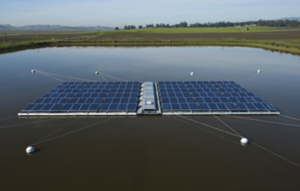
As the Government of India, targets power generation to the tune of 100 GW by 2022 from solar power. The need to set up more and more solar power plant is growing. The stated government policy is to setup solar farms on unproductive barren lands. But with spurt in solar farms, as a natural consequence prices of barren land earmarked for solar power projects have risen by at least 20-30 %. As more and more solar power projects with larger capacities are established on land, the availability of unproductive barren land is set to become scarce.
Floating solar PV plant is emerging as a cost-effective alternative to the land intensive conventional solar power plant. Floating solar plant can not only be setup in fresh water reservoir, lakes, large ponds but also in a saline water environment or sea. A Floating solar PV plant not only helps conserve water by cutting down the rate of evaporation, but also cools the solar panels better and faster. A floating solar power plant makes use of the same commercially available solar panels, and is cost competitive with respect to rooftop mounted and ground erected solar power systems.
In many parts of India, there is scarcity of cultivable land and plain barren land though available, has either undulating surface or is in areas where setting up solar farm is economically unviable. That means not much barren land is available. So, what is the solution; it is to set up solar farms on water bodies. India has abundance of large water bodies from reservoirs to lakes to rivers as well as oceans on western and eastern side with a coastline of over 7500 km. Kerala in particular has a great potential as it not just has sea but a huge network of inland waterways or back waters. So how good is to set up solar farms on water bodies. While there are many, a few important one have been listed below.
1. Increased Efficiency: – Solar cell efficiency refers to sun’s energy converted into electricity via photovoltaics (PV). As per data, not just life span efficiency of the solar cells used in a floating solar farm increases by as much as 19%, due to combination with latitude and climate among other factors. This has led to significant push towards setting up large scale floating solar farms in the United Kingdom, China, India, and Japan.
2. Water Volume Retention: – A floating solar plant helps retain large amount of water by providing a shade and save it from evaporation. The shade helps improve water quality making it more potable for drinking purpose. Not just that, the shade of a floating solar farm from sunlight; cools the water resulting in disruption in growth of water weeds that need sunlight for photosynthesis. The shade also helps stop growth of bacteria such as cryptosporidium and giardia; besides limiting algae growth.
3. Less Expenses: – Floating solar farms have the big advantage lowered costs because unlike land-based solar farms they don’t have to spend money on land acquisition, leveling, upkeep and maintenance, and insurance against flooding. As high voltage underwater electrical wires, are used to transfer power to the grid there is no need to setup a network of electric poles and wire. As the solar panels float on water it offers protection from high winds while reducing the need for erecting support structures, a must on land.
4. Lower Capital Cost: – Setting up a solar power farm on a water body costs less than what it costs to setup. For example, to generate 1 mw of solar power, solar panels need to be setup on 4 acres of land. At a capital cost of INR 7 crore per mw; the plant produces power at INR 8 per unit. On the other hand, area coverage of solar panels installed on floating platforms will be around 20 % less than the 4 acres needed on land. Capital cost to setup floating solar plant to generate 1 mw power is expected to be around INR 6.5 crore per mw, and the cost of power will be INR 7 per unit.
5. No Exclusivity: – To setup a floating solar power plant the only thing a prospector needs to do is to rent the surface of the water from the owner which is minimal since top of water body can be put to no use. Despite setting up a floating solar plant the water body on the whole be used to set up a fish farm. On the other hand, land-based power plants since setup in barren waste land in India’s case can rarely be put to other use like vegetable cultivation cash crop farming.
6. No Threat to Ecology: – Despite setting up a floating solar power plant, the ecology of water body is unlikely to be affected. A floating solar power plant not only helps cut water evaporation but curtails underwater weed generation. It not only helps preserve water levels during summer, floating solar panels are more efficient due to the act that cool water keeps the solar panel temperature under control. On the other hand, land based solar panels get heated due to the heat emanating from land which affects their yield.
7. Security: – An advantage of setting up a floating solar power plant is that system integrator, owners or power buyer; none have to worry about security with regards to theft of wires or solar panels or wires or any other machinery since these will be set up in middle of water, and it will be really difficult even for ingenious thief to burgle them. Another advantage is the protection from any kind of vandalism. Recently some people vandalized solar panels at a farm built on land in Maharashtra, India. But since floating solar plants will be built in middle of water with access only by a pontoon bridge or boat, so threat of vandalism does not exist.
8. No Water, No Worries: – The biggest advantage of setting up a floating solar power plant on a water body is that if water is scarce, power production still continues. For example, if a water body behind a barrage or dam, is used to produce electricity, it will continue to do as long as there is sufficient water. Once the water level goes down below certain level the turbines built beside the dams, reservoir, barrage can’t produce electricity. This is not the case with floating solar farm is setup on dams, reservoir, barrage. As these solar panels work on sunlight; no matter if there if the water level in reservoir drops drastically or goes bone dry, power generation will continue unabated
9. No Wastage of Water: – Another advantage of setting up a floating solar power plant on a water body is that even if the solar panels get dirty, a lot of water is readily available to clean them and above all the water doesn’t go waste and is retained in the water body. There is no need for taps, pipes just pick water in bucket and clean the solar panels. On the other hand, in case of solar farm on land, the owner, system integrator has to make arrangement to setup a water tank or use precious ground water and build a system of pipes and taps to clean the solar panels on regular intervals since dust is big issue on land. The dirt mixed water is virtually useless unless there exist a system to clean the water to make it reusable.
10. Initial Cost High but Cheap in Long Run: – Despite the fact that floating solar power plant is land neutral, the cost of setting up a floating photovoltaic system is high at the initial stage of development. In the initial stage costing of floating photovoltaic system includes; costing related to procurement of anchoring, installation, maintenance and transmission lines. This makes overall cost of the floating solar power system much higher than the land-based solar power systems. But in the long run, since the cost incurred on maintenance and other related issues like security are minimal coupled with increased efficiency, the overall cost of floating solar plant is much less than floating solar plant.
Existing, Current or Upcoming Floating Solar Power Plants Projects
The history of a floating solar power plant is not very old, though solar power plants are fairly new compared to coal, water, nuclear energy, geo thermal power; floating solar power plant is a more phenomenon that has caught the imagination only in last few years. A proposed 5MW project to build the largest grid connected floating solar power project in Murshidabad; West Bengal is in the offing with tenders to be floated in April 2018.
This floating solar project is to be developed alongside the Sagardighi Thermal Power Project, the project will be executed by West Bengal Power Development Corporation Limited (WBPDCL). WBPDCL will also setup 2 more similar projects; including a 5 MW project at Santaldih Thermal Power Project and a 10 MW project at Barkeswar Thermal Power Plant. Even Solar Energy Corporation of India (SECI) is planning to setup two 10MW floating solar PV projects in the states of Kerala and Andhra Pradesh. SECI intends to use floating structures and anchoring systems designed by Arka.
In future few more floating solar plants will be setup in Kerala to generate up to 72 MW project, as well as in Maharashtra and Uttar Pradesh respectively to generate 50 MW each. Lakshadweep Energy Development Agency (LEDA) also wants to setup 10 MW of floating solar projects in Lakshadweep. Like the 600 MW floating solar power project at the 1960 MW Koyna hydro power project, few more similar projects are in the offing in Kerala, Andhra Pradesh, Lakshadweep, Tamil Nadu, and Uttar Pradesh. India is home to large water bodies across many states like West Bengal, Orissa, Assam, Andhra Pradesh, and Kerala in particular.
In the last few years Japanese, American and Danish have gained various types of patents for floating solar power plants. Ciel & Terre, a company in France holds the Numero Uno status in the world with regards to commercializing floating solar power plants, having installed over 75 such plants in 16 countries. D3Energy, LLC is the leading floating solar developer in the USA. Currently, both Japan and Australia are on the verge of setting up floating solar power plants. Even World Bank under its Clean Technology Fund is supporting the development of floating solar power projects totaling 10 MW in India.
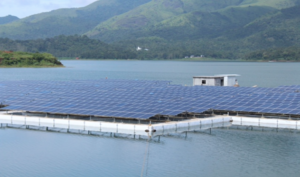
In case of India, Tata Power Solar, a private sector energy giant has joined hands with Australia’s Sunengy Pty Ltd for setting up US$1 million pilot project to build floating solar power plant. The plant is to make use of Liquid Solar Array technology developed by Sunengy; which is based on concentrated photovoltaic technology that makes use of a lens and a small number of solar cells to track the sun throughout the day. Liquid Solar Array effectively transforms water stored in a dam into a very large battery that offers free solar storage and water resource management system.
According to reports, with Sunengy’s Liquid Solar Array technology; if India can manage to even use 1% of its 11583 square miles of captured or stored water resources; it can produce green power equivalent to power generated by 15 large coal based power plants. As is known coal fired power plants cause pollution in the form of smoke, and generates lot of waste in the form of fly ash that needs to be properly utilized, which if left as it is; is an environmental hazard.
Hybrid Floating Solar Islands
Beside land based solar power plants and floating solar power plants a new type of photovoltaic solar farm is emerging. It’s called the Hybrid Floating Solar Islands that makes use of both land based solar plant as well as floating solar plant. Developed by SPG Solar and based on the company’s Floatovoltaics technology; a hybrid solar power system that is built on a water body and land not only helps conserve land but also saves water while generating a cleaner, renewable power with endless supply among others as an and environmental benefit.
Under this both land based solar farm and water based floating solar farm are built close to each other. Both the plants are connected to the electricity grid with the same power line; supplying nonstop power. SPG Solar’s Floatovoltaics hybrid floating solar power system is primarily designed to be installed and operated on fresh water. Meaning it can be used not just in ponds, lakes, but also in fish farms, reservoirs, abandoned mine shafts used for water retention and water storage tanks. This system not only helps to make full use of the land and water assets to full use but also helps to reduce energy costs. SPG Solar using its Floatovoltaics system has setup a 477-kilowatt hybrid land and floating solar island at a water retention pond in Far Niente winery in Napa County, California.
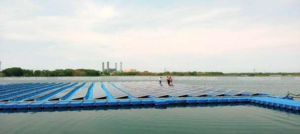
The hybrid plant has been operational for over three years as of now. Here just like other floating solar plants, the system has ensured significant reduction in algae growth and water evaporation. In SPG Solar’s proprietary Floatovoltaics system the solar panels are erected on a racking system that floats on a pontoon and is secured by a specially designed mooring system. The system is designed in such a way that it keeps all the metallic components above water, thus avoiding corrosion and leaving only the closed HDPE plastic floats under water, thus ensuring durability and longevity.
According to SPG Solar, the floats have been sanctioned for use water bodies meant exclusively for drinking purpose. Also, the system is designed to withstand winds up to speed of 85 mph and even frequent changes in water levels. Just like any other floating solar power plant; this system also provides environmental benefits like saves water from evaporation, stops algae growth and above all does not obstruct the water flow or its usage. According to SPG Solar, its system cuts water evaporation by 70%, the 3-acre storage pond covered with solar panels can save up to 4 million gallons of water per year.
World’s Largest Floating Solar Power Plant Comes up in China
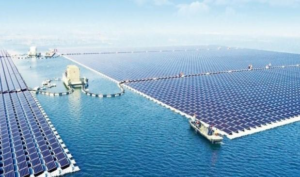
\In May, 2017 the world’s largest floating solar system with capacity of 40 MW went online in Huainan, China. Decades ago when a coal mine in eastern China collapsed, it created an enormous hole filled with water. Later added with other geographical features the entire area was developed into the Three Gorges Dam, the world’s largest hydroelectric power station; which when completed in May 2018, will generate a massive 22500 MW of electricity. However, it’s an irony that the same company that manages the dam will also manage the site of world’s largest floating solar power plant.
The new solar power plant operated by Three Gorges Group, is expected to help pull down the cost of solar power generation. The first phase of the project was completed in December 2017 with power lines connected to local electrical grid and is expected to bring more economic benefit to the area. According to reports, interest in floating solar plants in China has gone up many folds since its land based solar power farms mostly built in remote areas like Gobi Desert in Western China province can’t supply their power fully to areas that need power the most that is in the eastern sea coast. As such the best option was to put to use solar power plant built on a water body. Near the areas of Eastern China that has maximum population and maximum industrial growth that need constant power.
Conclusion
In May, 2017 the world’s largest floating solar system with capacity of 40 MW went online in Huainan, China. The largest floating solar power plant or solar farm of 500 KW capacity, the first of its kind in India went online in Wayanad, Kerala in December, 2017. Having evolved in just the last few years, as compared to land based solar plants that have been in existence for few decades, the floating solar plant can address a lot of issues not just related to environment but also efficacy of solar panel and its power generation capability. Not only it helps curtail excessive water evaporation, it stops algae and water weed from growing uncontrolled. The only major issue that still affects a floating solar power plant is corrosion from water and instability from rising water levels and high winds. Other issues like impact of corrosion on solar modules, cables, security, and maintenance need to be better addressed.
As the demand for floating PV systems rises; with technical advancements the cost setting up and operating a floating solar plant will go down considerably as compared to land-based systems. Many research institutes and companies are putting in lot of money and resources towards developing a solar panel with simpler design. This also has created the need for developing solar panels using materials for use in floating solar power system, that are stronger and longer. International funding agencies have also come forward to support the development of alternative solar power technologies. The German Development Bank KfW is funding development of two floating solar power projects of 40 MW total capacity in India, to demonstrate the feasibility of setting up such projects. All in all the floating solar power plant as a concept as well as a feasible project has great future in India. As India is home to large number of water bodies, and as clean title barren wasteland near the area of requirement, are not easily available to set up land based solar power plant, the chances of floating solar power plant look promising in India. Hope it helps to boost the setting up of more floating solar parks in India.
Source:-
https: mercomindia.com/west-bengal-floating-solar-tender
https://www.intersolar.in/en/news-press/news/industry-news/floating-solar-systems-potential-promise-and-challenges.html
https://www.outlookindia.com/website/story/indias-biggest-floating-solar-power-plant-to-be-inaugurated-in-kerala-on-monday/305083
http://www.financialexpress.com/photos/business-gallery/960039/india-largest-floating-solar-power-plant-banasura-sagar-reservoir-kerala/
https://economictimes.indiatimes.com/news/politics-and-nation/indias-largest-floating-solar-power-plant-opens-in-kerala/features-of-the-solar-plant/slideshow/61930257.cms
https://www.moneycontrol.com/news/business/economy/indias-largest-floating-solar-power-plant-in-kerala-to-start-operations-today-2453159.html
https://en.wikipedia.org/wiki/Floating_solar
https://currentaffairs.gktoday.in/tags/floating-solar-pv-plant
https://economictimes.indiatimes.com/industry/energy/bengal-to-award-indias-largest-floating-solar-plant-by-march/articleshow/63031516.cms
https://www.pv-tech.org/news/indias-largest-floating-solar-plant-completed-withstanding-huge-water-level
http://www.waterworld.com/articles/print/volume-27/issue-9/editorial-features/floating-solar-systems-provide-power-environmental-benefits.html
https://www.indiainfoline.com/article/news-sector-others/india-to-have-floating-solar-power-plant-113101904148_1.html
https://www.ibef.org/archives/detail/bmV3cyYzNjk1MSY2ODQ=
http://ieeexplore.ieee.org/document/8074182/
https://cleantechnica.com/2017/10/13/20-megawatts-floating-solar-power-projects-coming-india-soo
https://mercomindia.com/west-bengal-floating-solar-tende


thanks for the share nice article
Very informative article
On a similar matter, you could check a case study on “Technical and financial viability of Solar PV Projects in India” available with http://www.etcases.com/solar-photovoltaic-systems-bring-happiness-to-residential-societies.html
keep it up! have a great day!
dear
sir/madam
Thanks for the appreciation for writing the blog and do spread the word about our blog.
We do like to share useful information on solar power and renewable energy and technology and add our perspective and please share the info with your friends.
Keep watching this space for the latest blog updates and do watch our social media profile.